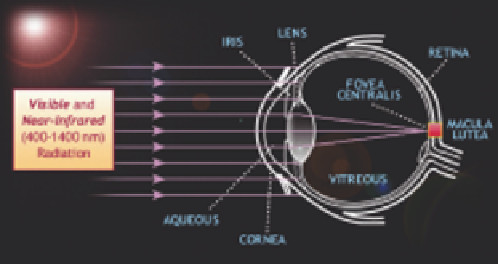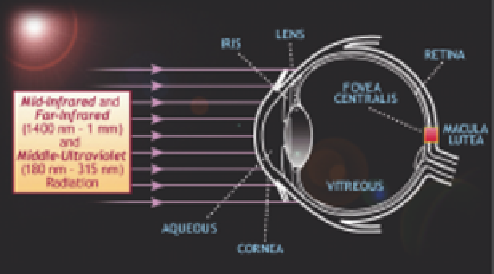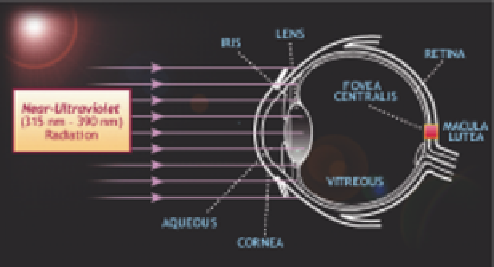Biomedical Engineering Reference
In-Depth Information
by the classifi cation of the laser, which must be included by the
manufacturer on the device and aperture labels. Current clas-
sifi cations have been adopted by the IEC as follows:
structures of the eye, absorbing in the hemoglobin in the ret-
ina, causing permanent damage to central vision (Fig. 17.5).
Furthermore, the human lens acts to cause convergence of
stray, low-power, refl ected or scattered beam emissions, which
can increase power density to a signifi cant level.
Class 1:
safe under every conceivable condition of use
Class 1M:
safe for viewing without optical aids, but
potentially hazardous with magnifi cation aids
(microscopes, loupes, binoculars, etc.)
Class 2:
visible wavelengths (400-700 nm) safe if viewed
for less than 0.25 seconds
Class 2M:
visible wavelengths (400-700 nm) not safe
with optical viewing aids
Class 3R:
marginally unsafe for intrabeam viewing of
beams with diameters >7 mm
Standards State
Eye protection devices specifi cally designated for the wave-
length and classifi cation of the laser in use should be worn in
addition to other controls that may be in place to ensure that
personnel will not be exposed in excess of the MPE level.
This means that everyone in a laser treatment room, within
the designated controlled area, must wear appropriate protec-
tive eyewear at all times when a laser device is in use. This
means all medical lasers, including CO
2
and Er:YAG. The only
exception to the rule of wearing safety glasses is when the phy-
sician is working through a properly fi ltered microscope.
There is no such thing as an “eye safe” Class 3b or Class 4 laser!!!
Criteria as follows should be used to select eyewear with
emphasis on the fact that all eyewear must be approved by
the LSO.
Class 3B:
unsafe for intrabeam viewing, causing skin and
eye injury from direct but not necessarily dif-
fuse energy
Class 4:
high power causing skin and eye injury from
direct and refl ected energy
Low-power lasers (e.g., those used in physiotherapy), are
usually of lower classifi cation, and the LSO must determine
control measures that are appropriate.
1. Permanent labels stating wavelength in nanometers
2. Permanent label stating the optical density (OD)
of >4.5
3. Ruby (694 nm) must have an OD of not <7
4. Side shield protection
5. Adequate visible light transmission
6. Resist shock, scratching, and front surface refl ection
7. Have proper fi t and be comfortable (no slippage)
8. Be without damage to lenses or frames
Ocular Hazards
Levels of ocular injury are determined by the interaction with
the tissue, and absorption chromophores that are present in
the structures that are exposed. Delivery systems, power and
energy density, and clinical application techniques also con-
tribute to the type and severity of damage that can occur.
Long wavelengths (CO
2
and Er:YAG) are absorbed by water in
the tissues, and therefore, can absorb at the tear layer covering the
cornea (Fig. 17.3). As the water is vaporized away, the beam
interacts with the tissues of the cornea to cause burns. This is not
permanent but can be painful and temporarily disabling or even
cause permanent scarring if deep enough. It can be particularly
hazardous should it occur intraoperatively, when the staff and
patient are at risk of injury should the user lose control of the
delivery system due to a “fl ash blinding” type of injury.
Mid-range infrared (Ho:YAG) can partially absorb, and yet
partially transmit through water, and be absorbed at the lens,
causing injury to the lens, but not to the retina (Fig. 17.4). This
is a permanent injury, similar to cataract damage.
Short wavelengths (near infrared through visible range) pen-
etrate through water and can transmit through all anterior
Figure 17.4
Mid-infrared radiation can cause damage to anterior segment,
and has the potential for serious injury.
Figure 17.3
Near-ultraviolet and near-infrared radiation (CO
2
, Er:YAG, and
excimer) penetrate only to the cornea and can cause temporary injury without
permanent damage to vision.
Figure 17.5
Visible and near-infrared (400-1400 nm) radiation can cause
damage to the retina and permanent injury.





















